5.8×42 Chinesse Assault Rifle
China Defense Blog
This is the blog of China defense, where professional analysts and serious defense enthusiasts share findings on a rising military power.
Wednesday, July 04, 2012
Type95/QBZ95-1 5.8x42mm Assault Rifle Hong Kong Debut Reloaded.



As the outgoing chairman of the CPC, Hu Jintao, parades down the Shek Kong Airfield of Hong Kong while being flanked by 3000 members of the PLA Hong Kong Garrison, China military watchers are excited, but not really surprised, to see the new and improved QBZ95-1 5.8x42mm assault rifle entering service. There is a well-known precedence to that – the first unveiled in public during the 1997 handover of former British Crown colony Hong Kong back into Chinese sovereignty.
Judging the QBZ95-1, sometimes wrongly called “QBZ95G” in the bloggosphere, one could start by voicing the opinion that this is the much and actually direly needed “A1” version of an otherwise quite decent assault rifle. The QBZ95 that has been in service with the Chinese military and export markets is decent assault rifle that originally suffered from a major design flaw, which could have been the result of its rush into service to show off to the world during the 1997 handover. The greatest flaw of course, is the severely awkward placement of the selector-switch: On the stock placed on the left-hand side. Considering that the PLA standard QCQ05 5.8x21mm SMG features an ergonomically sound selector switch placed above the pistol-grip on the left-hand side, and its own development was not known to be subject to any highly political pressure besides the fact that it was a bid to a PLA competition seeking for the next-generation SMG to replace the venerable Type 85 7.62x25mm SMG, it becomes ever more probable that the first QBZ95 version would not have had this major design flaw, if its development was not limited by an intensely short time frame due to political reasons.
This, in turn, could have made the development and introduction of the “-1” version rather unlikely, considering the frugal nature of the PLA who used the well-liked Type-81 7.62x39mm assault rifle more or less unchanged from its basic configuration since 1983 (ignoring the replacement of the solid-stock by a folding stock for the Type-81-1 version) to this day. The QBZ95-1 thus sports a selector switch, which is similarly placed at the right-hand side above the pistol-grip, allowing the operator to manipulate the firing modes and safety with his thumb.
The other improvements of the QBZ95-1 are of comparably lesser nature, but not to be ignored either: The replacement of the fluorescent illumination-dots on the front-sight with a pair of more reliable and longer-lasting tritium illumination dots, the redesign of the handguard which now features a diamond-shaped cross-section that wont heat up as much from a hot barrel due to the broader gap in-between handguard and the barrel, the addition of two very short rails under the front-sight to allow the mounting of tactical accessories (proprietary, non-picatinny), the lowering of the carrying-handle and the integrated propietary optics rail that now makes it more comfortable for the operator to use mounted scopes and sights, the removal of the integrated front-grip-trigger-guard combo present on the QBZ95 which now allows for custom front-grips and GP-25 styled grenade-launchers to be attached, and last but not least, the redesign of the lower receiver and the ejection port, which now features both a bolt hold-open feature (manually to be manipulated via a switch at the bottom of the lower receiver just behind the magazine port) and a theoretical left-handed operability of the bullpup rifle due to the solution of moving the ejection port 5mm to the front and adding a mechanism forcing the cases to reliably eject in a 45° arc towards the front away from the left-handed shooter’s face.
The externally apparent differences — another thing one must know about the QBZ95-1 was the apparent decision to develop it around a new version of the Chinese 5.8x42mm round. As we know, the previously used DBP87 and DBP95 rounds were subject to several budget-constrains. Due to the reasons of using cheap, dirty-burning powder and a corrosive primer (DBP87), utilizing lacquered steel-casings (DBP87, DBP95) performance was not insubstantially affected. The new type round the QBZ95-1 family is to be chambered for is designated as DBP10, which uses non-corrosive primer, a clean burning high-powered propellant, chopper-coated steel-casings, and a new bullet, which features a long, streamlined body not unlike the DBP88 5.8x42mm “heavy round” designed for LMG use in mind. This new bullet reportedly features a chopper-alloy jacket and a hardened steel-core with better armor piercing performance compared to the mild-steel cored DBP87/95. So, adopting an essentially “heavy round” as the future standard general purpose round for all Chinese 5.8x42mm chambered weapons, replacing all different dedicated 5.8x42mm round now in service, the DBP10 forced Norinco to add a thicker 18.2″ “heavy barrel” on the QBZ95-1, which, in combination with the much more high quality DBP10 round, gives the rifle a claimed accuracy of R50
Chinese Type 95 (QBZ95) 5.8x42mm Assault Rifle







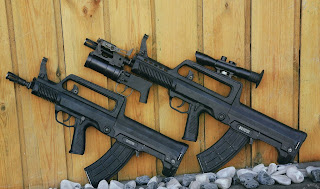



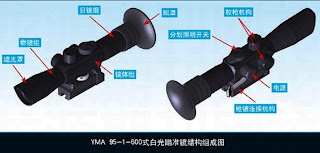
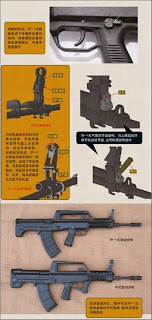
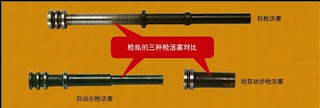
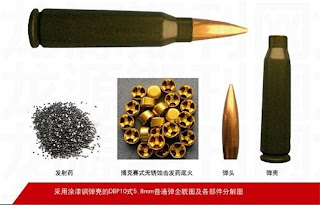



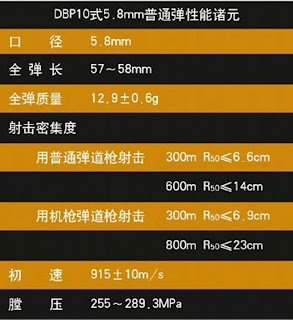
Share to:
Newer Post
Previous
Older Post
Post a Comment

too big for tiny chinese guy..make smaller guns that are practical. also do not imitate or copy. Design your own systems.

Above post is pretty irrelevant to what this is intended for. I’m pretty that’s what the US Marines will be saying when they fight. From what i’ve seen here, I’m pretty convinced by China’s military. Their use of a round smaller than 7.62mm is likely to have the same effect that one did on the AK. Smaller projectile = travels faster and further, with possibly improved armour penetration.
Their training, however, is unlikely to match that of US forces. Consider how long America has been doing it.
China has prove it’s worthy on the battle field against bigger and better arm nations. Korea and v. It’s not the guns it’s who’s at the trigger.

The trouble with US is its persistent belief that it is the centre of universe, and shall remain so. With its mighty propaganda machines and Hollywood-styled make beliefs, besides its technological head start, it continue to exert hegemonic masculinity over the rest of the word.
Defeats in the hands of the impoverished Chinese in the Korean and Vietnam wars were spun to appear like victories. To make up for the dented egos, they trained their overwhelming technological fire power on perceived and imaginary foes who fought and fight with literally “bows and arrows”!
However one spun, the mighty US army and its allies lost the both wars to the impoverished, undernourished, under equipped and physically “smaller” Chinese. Then the technological odds were 9:1 in US’s favor. Today, it may still be 7:3 in US’s favor. But my advice: Don’t send Rambo!
Sent from my iPad

anonymous the us marines are a bunch of fucking idiots that’s why they lost their strategy was horrible. in war china will kick Americas ass, since they have a much large production industry which will make the Chinese have a larger amount of weapons out competing the us and having a larger army with a super power as its ally and north Korea with lots of nukes and weapons. US had some small allies and there large allies have economies close to collapsing. So anonmyous stop posting shit.

The Chinese military tactics are quite basic its all was strict to the letter orders on how to act to a situation with no deviation,
american tactics are do what you think is best for the situation at hand adapt and over come ect but when it comes to on the ground experience america has 60 years of modern combat experience but with china they have seen but not experienced
personally ageist 3 million PLA id take 1 million us army. (and 200 thousand British)
On topic after firing the QBZ-95 not a bad wee weapon ill still take an SA80a2

i agree with all above. the americans can’t even get into africa without getting their asses kicked. lol. PITY THE FOOL
In the past 30 years what modern combat has Chain had?
The US has been involved in the largest ground combat battles in 20th century operations in Deseret Storm 1 and lets not forget Deseret Storm 2.
Again what combat prove troops or equipment do they have?
Yes China could out man the use 4 to 1 in soldiers but as we seen this did not help the Iraqis..

While it’s true that China may be technologically lagging, and also in training [but now building a largely professional army] and actual combat experience, what may happen in a conflict between China and America is a bogged out war of attrition. The US can’t invade China or vice versa; they are just too big a country, so too much territory to capture. Unlike Iraq which is mostly desert, China/US is packed with people (and in the US, populace with guns!) and holding territory while maintaining population control will be difficult, especially if said local populace is hostile. Terrain is also widely varied which requires huge resources to tackle. China has a huge army which would counteract the [slowly shrinking] technological/military superiority of the Americans but more critical is the fact that China has many chains of material supply spread all around the country. One thing they know is mass production, so replacements can be called up quickly. It was much the same in WW II where the Germans (e.g. Panzer tanks, combined arms tactics) and Japanese (e.g. Zero fighter, naval tactics) were technologically/tactically ahead of the Allies at the beginning, but material numbers and gradual technological advancement on the Allied side equalized the situation. Two large nations with huge resources despite different strengths would end up in a stalemate.

its very late to develop tactical qzb 95
China need 20 years again to controll western pacific rim. But to make equal US superiority 20 years isn’t enough. Financial crisis just make an small effect to US military.

China is a disgrace. Your a nation of belligerent thieves. Actually invent something instead of stealing then you might get some respect.

US is the largest copyright hacker during 1910 to 1930, and deemed low intelligent by mighty europeans. It is with the help of immigrants that US gained gradually the dominance of advanced weapon system.
China is catching up in the tech and science area, especially in military field. Chinese kicked Americans ass in 1951 with much disadvantaged weapons,

You are most likely something designed to be sent to mid east frontier to die for oil tycoon and jewish elites who make you believe you are doing the right thing to fight thousands of miles away with people who have nothing to do with you.

chinese products are junk, unreliable and could end failure, you will utilize it for war? i dont think so that it could save your life. the americans does not need to engage the chinese in air, sea and land they just leave the chinese equipment in utility, in a couple of weeks all their equipment will break down. chinese quality!
Type 95 / QBZ-95
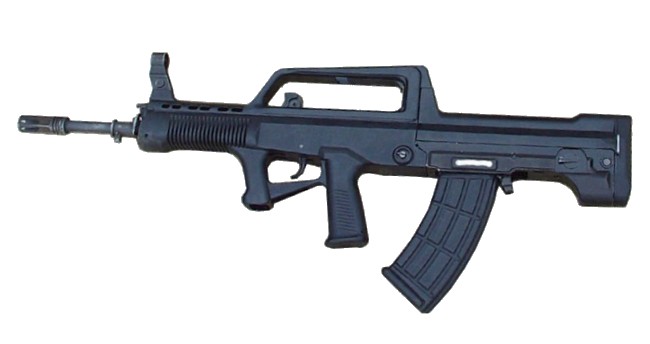
5.8x42mm QBZ-95 assault rifle, left side view
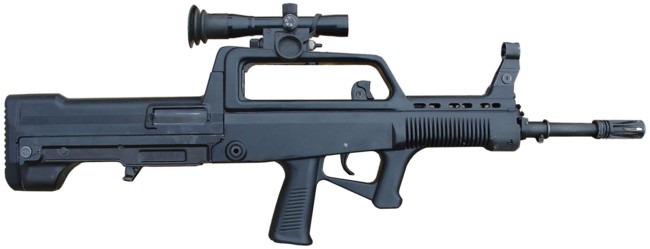
5.8x42mm QBZ-95 assault rifle, right side view; magazine is removed and a 4X telescope sight is installed
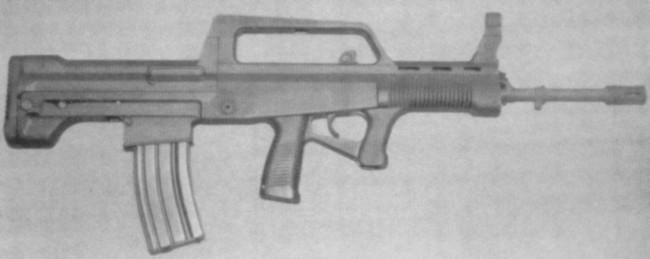
5.56x45mm QBZ-97 / Type 97 assault rifle; note different magazine port, designed to accept STANAG / M16-type magazines
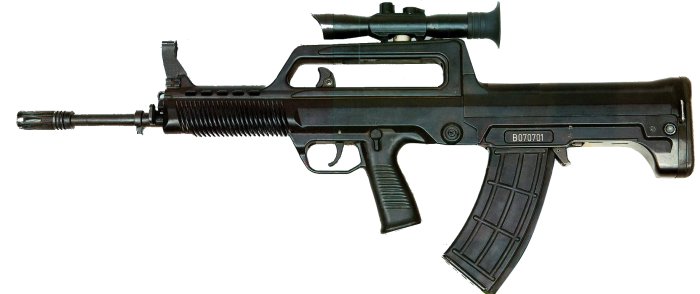
improved 5.8x42mm QBZ-95-1 (Type 95-1) assault rifle

5.8x42mm QBZ-95-1 (Type 95-1) short assault rifle (carbine) with new 35-mm underbarrel grenade launcher
Data for QBZ-95 (QBZ-97 in parenthesizes, where differs from QBZ-95)
Caliber: 5.8×42 mm (5.56×45 mm NATO)
Action: Gas operated, rotating bolt
Overall length: 760 mm
Barrel length: 520 mm
Weight: 3.4 kg unloaded
Rate of fire:
650 rounds per minute
Magazine capacity: 30 rounds
In the late 1980s Chinese designers developed a 5.8 x 42 cartridge, apparently designated DBP87, which is claimed to be superior to both the 5.56 mm NATO and the 5.54 mm Soviet. This cartridge develops a muzzle velocity of 930 metres per second from a standard barrel, with a bullet weighing 4.26 gram.
As soon as the ammunition was ready, the PLA began to develop an entirely new and much more modern family of small arms based on the same action. This family, known as QBZ-95 (‘Qing Buqiang Zu’ = Light Rifles family, 1995), was first displayed outside the PLA in 1997, when China took over Hong Kong; it was observed that the Chinese guards were armed with a new, modern looking bullpup rifle. In fact it is one of an entirely new family of weapons, all designed around the same action and bullpup layout, which include the assault rifle, a shorter carbine, a light support weapon (with a bipod, a heavier barrel and large capacity magazine), and a sniper rifle. While being quite similar inside, these guns have different body shapes and cannot be converted from one configuration to another. The QBZ-95 line of weapons is now spreading throughout the PLA, commencing with elite units.
The QBZ-95 is a gas operated, magazine fed, automatic weapon with a bullpup layout. It has a short stroke gas piston and a rotating bolt. The charging handle is located at the top of the receiver, under the carrying handle. The housing is made from polymer, with an integral carrying handle, which holds the rear sight base, and has mounting points for optical or night vision scopes. The ejection port is made only at the right side of the weapon, so it cannot be fired from the left shoulder. Standard sights are of the open type, graduated from 100 to 500 meters. The front part of the barrel in the standard version is left unobstructed, so the QBZ-95 rifle can be used to launch rifle grenades. It also can be fitted with an underbarrel grenade launcher or with a knife bayonet. A compact carbine version, sometimes referred to as the CAR-95, cannot use either a grenade launcher or a bayonet, because of the much shortened barrel. Fire controls of QBZ-95 rifle consist of a trigger and a safety/selector switch, located (quite inconveniently) at the rear left of the receiver, behind the magazine housing. QBZ-95 can fire single shots or bursts.
The export version, QBZ-97, which is chambered for popular 5.56 x 45 NATO ammunition, is internally similar to QBZ-95, but has a different, much deeper magazine housing, which accepts a NATO-standard (M16-type) magazines.
During 2010-2011 PLA has adopted an improved version of the Type 95 / QBZ-95 rifle, known as Type 95-1 / QBZ-95-1. This rifle includes several important improvements, based on the field experience with original rifles. Polymer stock is made stronger, barrel is mproved to provide longer service life and better accuracy. Pistol grip and trigger aguard are redesigned, and selector / safety switch is moved to much more comfortable position, right above the pistol grip. Other improvements include addition of the bolt hold-open device and gas regulator. Ejection port is moved forward slightly to ensure that spent cases are ejected forward and to the right, allowing for left-hand shooting if necessary. Type 95-1 / QBZ-95-1 rifles and carbines now can be equipped with new, 35-mm underbarrel grenade launcher, known as QLG-10A. Rifle grenades still can be fired from the muzzle using special blank ammunition.
The Firearm Blog
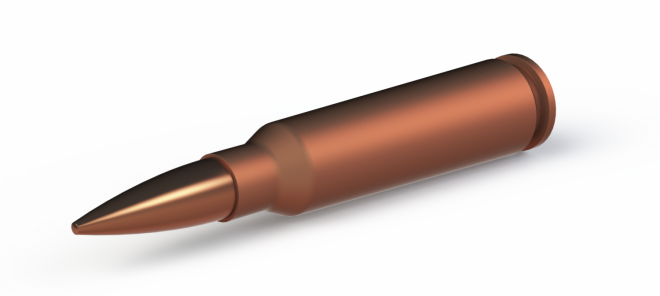
In the mid-1950s, the People’s Republic of China followed the Soviet Union’s example and adopted the intermediate 7.62x39mm round. This decision substantially helped to promote that cartridge’s ubiquity throughout the world, as millions of cheap Chinese-made SKS and AK rifles were exported to every corner of the globe. However, at the very end of Chairman Mao Zedong’s regime, an effort was started to develop a new, modernized caliber that would improve performance and conserve materials versus the 7.62×39. That program resulted in the 5.8x42mm caliber, standardized in the late 1980s with the DBP-87 and DBP-88 rounds. Unusually, the 5.8x42mm used a system with two different overall length standards, one of about 58mm for the DBP-87 rifle cartridge, and the other of about 62mm for the DBP-88 support round. This allowed the marksman’s rifle to shoot the DBP-87, if necessary, but also allowed for a longer, lower drag bullet to be put in the DBP-88 case, improving the ballistics of the QBU-88 marksman’s rifle and the QJY-88 general purpose machine gun.
By the 2000s, this “one and a half” caliber system was proving suboptimal, and so a program to develop a new universal round for both the QBZ-95 assault rifle and QBU-88 marksman’s rifle was begun, resulting in the DBP-10 projectile, which combines the best aspects of the DBP-88 and DBP-87, while being compatible with all weapons. This DBP-10 round is the standard infantry caliber for the People’s Liberation Army today, although stockpiles of older ammunition still exist.
On to the ballistics:
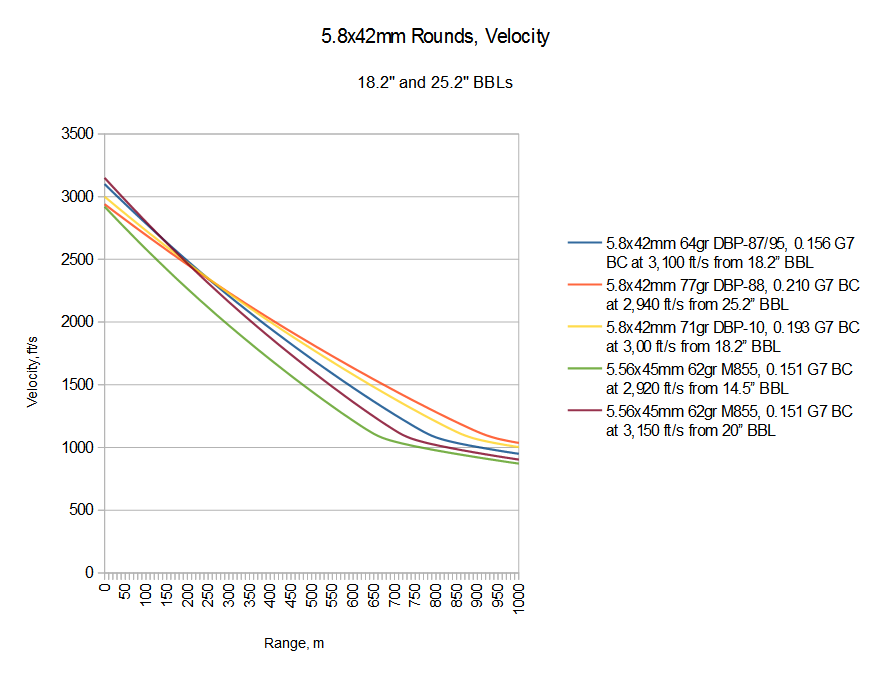
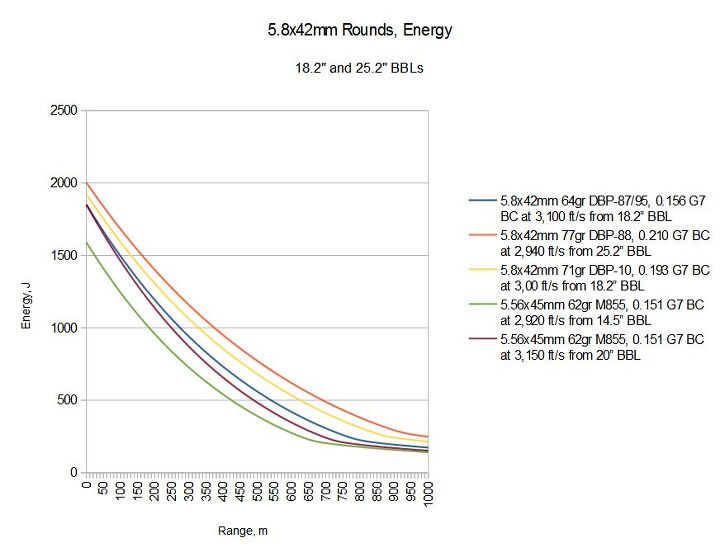
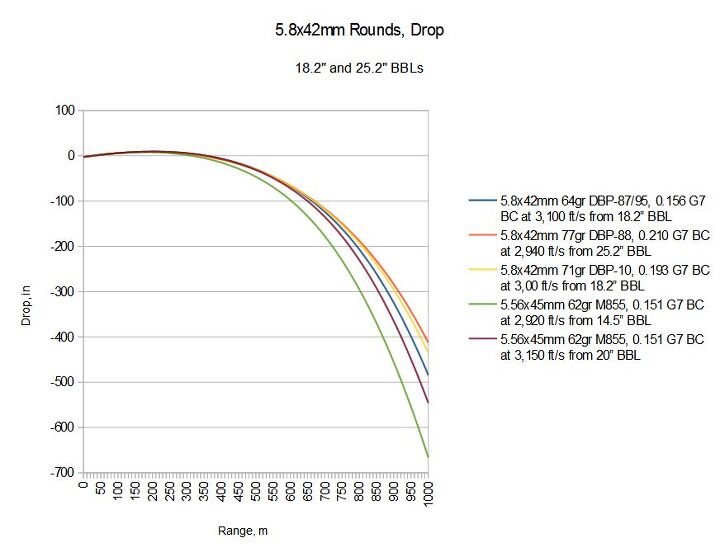
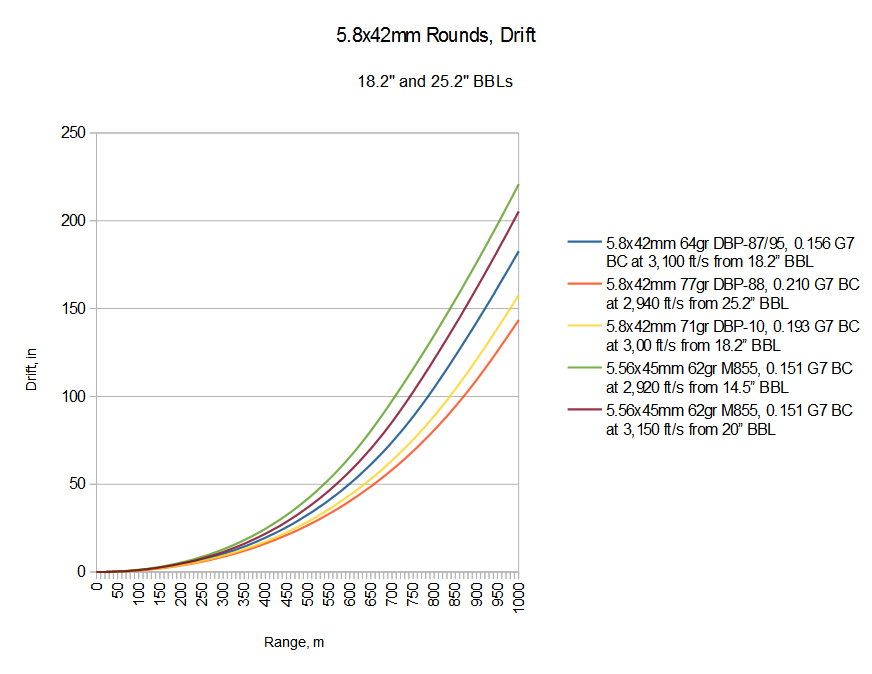
Despite having better performance than 5.56mm at extended distances, the 5.8mm DBP-10 cartridge isn’t much heavier, at just 12.9 grams per shot (7.5% more).
Note: All ballistic calculations are done with JBM’s Trajectory calculator, using the ballistic coefficient appropriate to the projectile being modeled, and assuming an AR-15 as a firing platform. Also, keep in mind that there is no single true velocity for a given round; velocity can vary due to a large number of factors, including ambient temperature and chamber dimensions. Instead, I try to use nominal velocity figures that are representative of the capability of the round in question.



